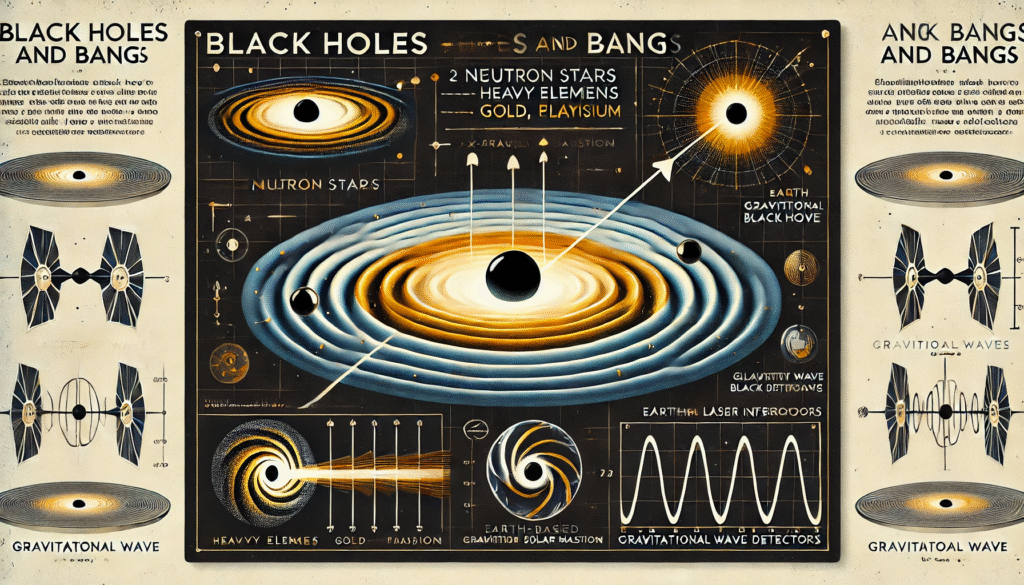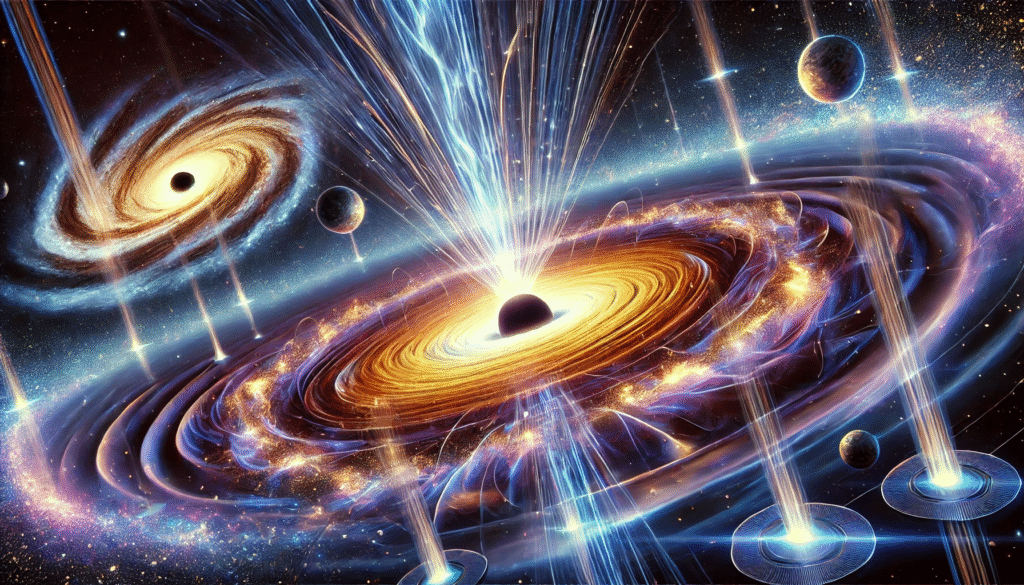
ChatGPT:
Black Holes and Bangs – Chris Lintott (Gresham Lecture, 2024)
This lecture explores the discovery and study of gravitational waves and black holes, showing how once purely theoretical concepts have become central to modern astronomy. Chris Lintott traces the journey from Einstein’s relativity to LIGO’s groundbreaking detections, the astrophysical significance of neutron star mergers, and the role of black holes in galaxies.
Conclusion
Chris Lintott emphasizes that gravitational waves and black holes, once considered speculative, are now observed realities shaping our understanding of the cosmos. The detection of GW170817 revealed that neutron star mergers create both gravitational waves and heavy elements like gold. LIGO’s precision instruments, sensitive to changes smaller than a proton’s width, opened a new window on the Universe. Observations of Cygnus X-1 and quasars confirmed that stellar and supermassive black holes not only exist but drive some of the most energetic processes in space. Black holes are now recognized at the centers of galaxies, including the Milky Way, influencing their evolution. Theorists continue to grapple with mysteries like Hawking radiation and singularities, while instruments such as LISA and the Event Horizon Telescope promise even deeper insights. A century after Schwarzschild’s solution, black holes remain both enigmatic and central to astrophysics.
Key Points
🌌 Gravitational waves: Ripples in spacetime predicted by Einstein, first directly detected in 2015.
💥 GW170817: A neutron star collision detected via both light and gravitational waves, proving such mergers forge heavy elements like gold.
🔭 LIGO interferometers: Use 4 km laser arms to detect changes as small as 1/10,000th of a proton, making gravitational wave astronomy possible.
📡 Hulse–Taylor pulsar: Provided the first indirect evidence of gravitational waves by showing orbital decay from energy loss.
⚫ Black hole confirmation: Cygnus X-1 (1970s) proved stellar-mass black holes exist, exceeding neutron star mass limits.
🌠 Supermassive black holes: Quasars and galactic nuclei revealed that most galaxies, including the Milky Way, harbor central black holes.
🌀 Accretion disks: Matter spiraling into black holes produces intense radiation, especially x-rays, explaining paradoxical “light from darkness.”
🧵 Spaghettification: Extreme tidal forces stretch objects falling into a black hole, though the crossing of the event horizon itself is uneventful.
🛰 Future missions: LISA will detect low-frequency gravitational waves from merging supermassive black holes.
🔥 Unsolved mysteries: Hawking radiation, the nature of singularities, and black hole thermodynamics remain theoretical frontiers.
Summary
- The lecture begins with the description of a real gravitational wave detection, a reminder that spacetime itself is dynamic and Earth is part of this cosmic “choppy sea.”
- The famous 2017 neutron star merger (GW170817) was the first event observed in both gravitational waves and light, confirming theories about kilonova explosions and the creation of heavy elements.
- Einstein predicted gravitational waves in 1917, but he himself doubted they could ever be detected due to their faintness.
- The Hulse–Taylor pulsar in 1974 gave the first indirect proof, as orbital energy loss matched predictions from gravitational radiation.
- Early detection attempts using resonant bars failed, but the development of LIGO’s interferometers allowed eventual success after decades of funding battles and technological advances.
- LIGO’s first detection in 2015 captured the merger of two black holes, producing a “chirp” signal that matched relativity’s predictions.
- Black holes, once theoretical “dark stars,” gained credibility after Cygnus X-1 showed an object too massive to be a neutron star.
- Observations of quasars and galactic centers established that supermassive black holes drive energetic emissions and shape galaxies.
- Black holes are not cosmic vacuum cleaners; they interact mainly through accretion processes, heating infalling material into x-ray-emitting disks.
- Despite immense progress, fundamental puzzles like Hawking radiation, the interior of black holes, and the limits of the “no hair theorem” keep them at the forefront of physics research.
What are gravitational waves?
Gravitational waves are ripples in spacetime caused by accelerating massive objects, such as colliding black holes or neutron stars. They were predicted by Einstein in 1917 and directly detected for the first time in 2015 by LIGO.
GW170817, detected in 2017, was the first event observed through both gravitational waves and light (gamma rays, optical, and x-rays). It confirmed that neutron star mergers produce heavy elements like gold and platinum, proving key theories of astrophysics.
How does LIGO detect gravitational waves?
LIGO uses laser interferometers with arms 4 km long. As a gravitational wave passes, it slightly stretches and compresses spacetime, changing the distance the laser beams travel. The shifts detected are smaller than 1/10,000th of a proton’s width.
What was the Hulse–Taylor pulsar discovery?
In 1974, astronomers Russell Hulse and Joseph Taylor found a binary pulsar system whose orbit was shrinking exactly as predicted if it were losing energy to gravitational waves. This was the first indirect evidence that gravitational waves exist.
What is a black hole?
A black hole is a region of space where gravity is so strong that nothing, not even light, can escape. The boundary is called the event horizon, and its size depends only on the black hole’s mass.
How do we know black holes exist?
Evidence comes from observing stars orbiting invisible massive objects (like in the Milky Way’s center), x-ray binaries such as Cygnus X-1, and emissions from quasars powered by supermassive black holes.
Can we see light from a black hole?
Not directly. But matter falling into a black hole forms an accretion disk that heats up and radiates light, especially x-rays. This is why black holes can be some of the brightest objects in the Universe.
What is spaghettification?
It’s the stretching of objects falling into a black hole due to extreme tidal forces. An astronaut approaching a stellar black hole would be pulled into a long, thin shape before crossing the event horizon.
Do all galaxies have black holes?
Yes, current evidence suggests that nearly all large galaxies, including the Milky Way, have supermassive black holes at their centers, often millions to billions of times the mass of the Sun.
What is Hawking radiation?
Stephen Hawking proposed that black holes slowly emit energy due to quantum effects near the event horizon, meaning they could evaporate over time. This radiation has not yet been observed.
What is the “no hair theorem”?
It states that from the outside, a black hole can only be described by three properties: mass, spin (angular momentum), and electric charge. All other details of the matter that formed it are lost.
How do black holes form?
Stellar black holes form when very massive stars collapse at the end of their life. Supermassive black holes may grow from early dense stars, mergers of smaller black holes, or processes not yet fully understood.
What role do black holes play in galaxies?
They regulate galaxy evolution by releasing jets and radiation from accretion disks, which can slow down star formation. Their growth seems linked to the development of their host galaxies.
What is LISA and why is it important?
LISA (Laser Interferometer Space Antenna), set to launch in the 2030s, will detect low-frequency gravitational waves from merging supermassive black holes, which cannot be observed from Earth.
Why do astronomers study black holes?
Because they are natural laboratories of extreme physics, testing relativity, quantum mechanics, and thermodynamics in ways impossible on Earth. They also shape galaxies and create the Universe’s most powerful events.

🌊 Gravitational Waves in Depth
🔭 What Are Gravitational Waves?
Gravitational waves are ripples in the fabric of spacetime itself. They were first predicted in 1916 by Albert Einstein as a direct consequence of his General Theory of Relativity, which describes gravity not as a force but as the curvature of spacetime caused by mass and energy.
Imagine spacetime as a giant elastic sheet. If a planet or star sits on it, the sheet bends. When two massive objects move violently (for example, two black holes spiraling together), they create ripples in this sheet that travel outward at the speed of light. These ripples are gravitational waves.
⚡ Properties of Gravitational Waves
- Speed: They travel at the speed of light.
- Amplitude: Extremely small — even the strongest events change distances on Earth by less than the size of a proton.
- Frequency range: Detected signals range from a few Hz (stellar black hole mergers) up to thousands of Hz (neutron star mergers).
- Transparency: Unlike light, gravitational waves pass through matter almost unaffected, carrying “clean” information from regions we cannot see (like black hole interiors).
🌌 Sources of Gravitational Waves
Only the most extreme astrophysical events can produce waves strong enough for us to detect:
- Merging Black Holes – Two black holes orbit each other, radiating gravitational waves, spiraling inward, and colliding in a powerful burst.
- Neutron Star Collisions (Kilonovae) – These events produce both gravitational waves and light, creating heavy elements such as gold and platinum.
- Black Hole–Neutron Star Mergers – A neutron star is swallowed by a black hole, generating waves.
- Supernova Explosions – Collapsing stars may create waves, though harder to detect.
- Cosmic Background Waves – A faint “hum” from the early Universe, possibly dating back to the Big Bang (still a target for detection).
🧪 Detection of Gravitational Waves
Gravitational waves are incredibly faint, so detecting them requires extraordinary precision.
LIGO and VIRGO Interferometers
- LIGO (USA), VIRGO (Italy), and KAGRA (Japan) are the main ground-based detectors.
- They use laser interferometry:
- A laser beam is split into two beams traveling down 4 km-long arms at right angles.
- They reflect off mirrors and return. Normally, they cancel each other out.
- But when a gravitational wave passes, one arm is stretched while the other is squeezed, changing the interference pattern.
- Sensitivity: Measures changes in length smaller than 1/10,000th of a proton!
Key Milestones
- 1974: Indirect evidence from the Hulse–Taylor binary pulsar.
- 2015: First direct detection — two black holes merging (GW150914).
- 2017: GW170817, the first detection of both gravitational waves and light from a neutron star merger.
🎶 The Sound of the Universe
Gravitational waves can be “translated” into sound because they create oscillations.
- Black hole mergers sound like a “chirp” – frequency rises as they spiral closer.
- The final collision produces a ringdown (like a struck bell).
These audible signatures give direct insight into masses, spins, and distances of the colliding objects.
🌀 What Do Gravitational Waves Teach Us?
- Black Hole Populations – LIGO has revealed dozens of black hole mergers, letting astronomers measure their masses and spins.
- Heavy Elements – GW170817 proved that gold and platinum are made in neutron star mergers.
- Testing Relativity – Waves match Einstein’s predictions precisely, even under extreme conditions.
- Cosmic History – Future detectors (like LISA in space) may detect waves from the early Universe, offering a new probe of the Big Bang.
🚀 The Future of Gravitational Wave Astronomy
- LISA (ESA, ~2035 launch): A space-based detector with satellites millions of km apart, tuned for supermassive black hole mergers.
- Einstein Telescope & Cosmic Explorer: Next-gen ground detectors, more sensitive and capable of detecting farther and fainter events.
- Pulsar Timing Arrays: Using radio pulsars across the galaxy to detect low-frequency waves from supermassive black holes.
🌟 Why They Matter
Gravitational waves are revolutionizing astronomy, just as Galileo’s telescope did 400 years ago. Instead of just “seeing” the Universe, we now listen to its vibrations, gaining access to phenomena invisible to light.
They allow us to:
- Peer into the hearts of black hole collisions.
- Understand galaxy evolution via supermassive black holes.
- Trace cosmic history back to the dawn of time.
👉 In short: Gravitational waves are the Universe’s soundtrack — faint ripples that let us hear cosmic events billions of light-years away.

